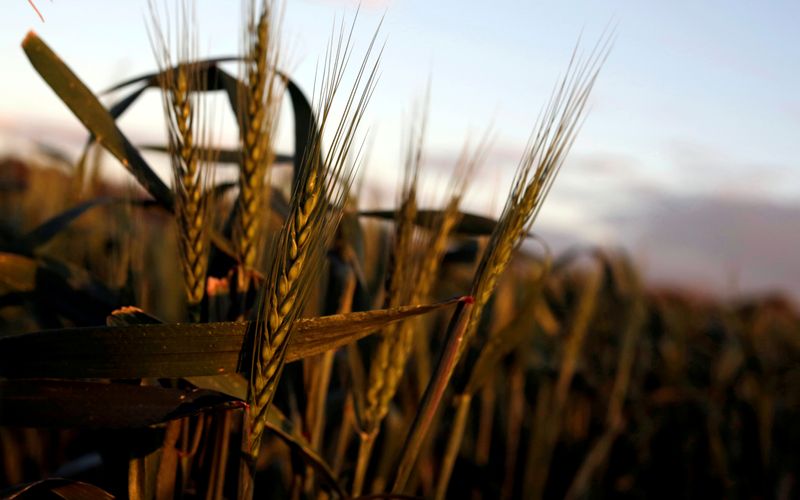By Jonathan Barrett and Swati Pandey
SYDNEY (Reuters) - Just months after rains broke Australia's crippling three-year drought, fields of grain have sprung to life, lifting forecasts for a bumper wheat harvest and reviving the beaten up agricultural sector through roaring tractor sales and increased lending.
The mid-season crops in some of the country's major eastern grain-growing areas are as lush as some industry veterans can remember, representing one of the few bright spots in the country's pandemic-affected economy.
"I moved here 30 years ago, and I've never seen it this good. It is magnificent. It is wheat, barley, everywhere as far as your eye can see," tractor dealer Roger Moylan said this week from Quirindi, a major grain-growing area in New South Wales (NSW) state.
Moylan, from North West Farm Machinery, said sales of tractors and augers, used to move grain from trucks into silos, were booming.
"If auger sales are through the roof, that tells you one thing - there is going to be grain everywhere," he said.
Australia was one of the top four global wheat exporters before the unrelenting drought started slashing production.
The country's chief commodity forecaster recently lifted its wheat production forecasts for 2020-21 to 26.7 million tonnes, more than 75% above the prior year's level and the highest since Australia's record 35.13 million tonnes in 2016–17.
Australia's 10-year average is just over 24 million tonnes.
(GRAPHIC - Australia eyes ‘magnificent’ wheat crop after drought-ending rains: https://fingfx.thomsonreuters.com/gfx/ce/yzdpxnxgrpx/AustraliaWheatOutputandMap.png)
This year's production could rise to as high as 30 million tonnes if export-focused Western Australia receives a good drenching in the next two months, said one Singapore-based trader at an international trading company that supplies Australian wheat to Asia.
RISKS REMAIN
Given most farmers won't start harvesting until October at the earliest, there remains uncertainty over crop production, especially in Western Australia that does not currently have the high soil moisture levels of NSW.
Western Australia and NSW are the top two wheat-producing states in the country.
Lyndon Mickel, who has a 6,000 hectare farm near Esperance in Western Australia's southern wheat belt, told Reuters that some recent rain had lifted spirits after a dry start to the season.
"We are sitting on a knife edge," he said.
"If we can get some decent falls across the state in the next month we could come into a decent yield."
(GRAPHIC - Australia soil moisture levels and wheat production estimates: https://fingfx.thomsonreuters.com/gfx/ce/qmypmkaympr/AustWheatSoil.png)
Benchmark wheat prices
Australian wheat exports this season are expected to nearly double from last year, the Australian Bureau of Agricultural and Resource Economics and Sciences said in June.
Yet souring diplomatic relations between Canberra and Beijing have also created a stumbling block for some grain farmers, after China effectively banned Australian barley imports in May via an 80.5% tariff.
China accounts for more than one-fifth of agricultural exports from Australia, taking almost twice as much produce as the second largest destination, Japan.
"Australia would probably need to diversify its trading partners especially to south-eastern Asian economies, where population is growing rapidly," Natixis economist Alicia Garcia-Harrero wrote in a note.
SMALL TOWN AUSTRALIA
The long-awaited economic activity emerging in many small towns is a godsend for a rural sector still recovering from one of Australia's worst-ever droughts that wilted crops and forced some communities to truck in drinking water in the country's east.
Grant Cairns, head of agribusiness at Commonwealth Bank of Australia (AX:CBA), told Reuters demand for equipment finance surged 27% in June from a year ago while demand for land purchases were strong too.
"Our customers have sought to sow crops and replenish livestock that they've had to de-stock through the drought," Cairns said.
NSW farmers have significantly expanded the size of their sown areas to push the country's total winter crop acreage to above long-term averages, a government crop report said.
Tractor sales breached the 2,000 mark in the month of June, according to the Tractor and Machinery Association of Australia, the first time it has done so since 1981.
"It shows how resilient and how quickly farmers got back into the saddle and started buying equipment, said the association's executive director, Gary Northover.

"Many dealers are even talking about increasing employment - there aren't many industries doing that in a pandemic."